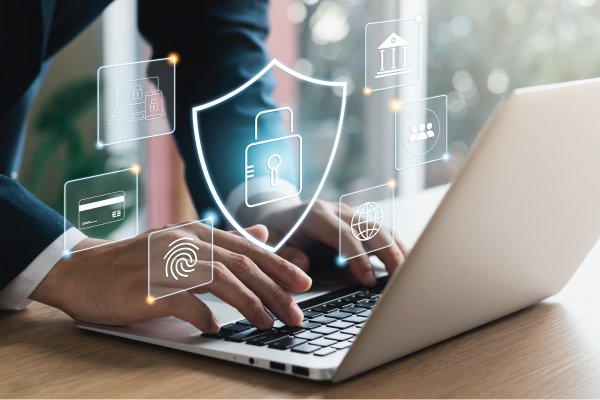In 2024, 600 million cyberattacks occurred every day1. Cybercrime in the U.S. caused reported losses exceeding $16 billion, a 33% increase from 2023, according to the FBI2.
With the rapid development of AI, cyberattacks will only increase — making it more important than ever for organizations to defend themselves.
Tom Cunningham is responsible for cybersecurity at Health Center Partners of Southern California, and these are his top four tips to build a resilient cybersecurity program and a culture of safety.
1) Conduct a Security Risk Assessment: Establishing a Baseline for Cybersecurity Posture
A comprehensive security risk assessment is a foundational step in strengthening an organization’s cybersecurity posture. It involves identifying, evaluating, and prioritizing risks to the organization's information assets, systems, and operations.
By conducting this assessment, the organization gains a baseline understanding of its current security strengths and vulnerabilities. This baseline serves as a reference point for measuring future improvements, guiding strategic decisions, and allocating resources effectively.
A security risk assessment typically involves:
- Identifying critical assets
- Analyzing potential threats
- Assessing system vulnerabilities
- Evaluating the impact of possible incidents
- Prioritizing risks based on their likelihood and severity
This structured approach helps organizations focus their security efforts where they matter most.
The Cybersecurity and Infrastructure Security Agency (CISA) offers free self-assessment tools which help organizations of all sizes assess their cybersecurity posture against recognized standards and best practices, such as NIST, CIS Controls, and others.
2) Implement Technical and Administrative Controls
Technical controls are key tools for enforcing security policies:
- Firewalls manage network traffic based on set rules and can be hardware or software based.
- Endpoint detection and response (EDR) monitors endpoints for threats like ransomware and enables quick response.
- Multi-factor authentication (MFA) adds layers of verification beyond passwords, such as tokens or biometrics.
- Encryption protects data both at rest and in transit, ensuring confidentiality and integrity.
- Patch management keeps systems updated to fix vulnerabilities and prevent exploitation.
Administrative controls are essential policies and procedures that guide how security is managed:
- Security awareness training helps employees recognize threats like phishing and social engineering, reducing human error.
- Access control policies define who can access resources, using principles like least privilege and role-based access.
- An Incident response plan ensures timely and coordinated action during security events.
- Risk assessment identifies and prioritizes threats to inform mitigation strategies.
- Vendor and supply chain security management ensures third parties meet security standards through due diligence and ongoing oversight.
3) Accommodate Software Updates and Patching
Regularly updating and patching software is a critical component of maintaining a secure I.T. environment.
Software updates often include patches that address known vulnerabilities discovered by developers or reported by the cybersecurity community.
When systems, browsers, and applications are not kept up to date, they become easy targets for attackers who exploit these weaknesses to gain unauthorized access, deploy malware, or disrupt operations. Outdated software can also lead to compatibility issues, performance degradation, and non-compliance with industry regulations.
Implementing a consistent patch management process — one that includes timely updates, testing, and verification organizations — can significantly reduce an organization’s attack surface and improve overall resilience.
Automated tools and centralized patch management platforms can streamline this process, ensuring that critical updates are applied across all systems without delay.
4) Build a Human Firewall: Empowering End Users in Cybersecurity
End users are often the last line of defense when it comes to cybersecurity, which is why building a strong "human firewall" is so important.
One of the most effective ways to do this is by helping people recognize and report phishing attempts. Phishing remains one of the most common tactics used in data breaches, so training employees to spot suspicious emails, texts, and phone calls is essential.
Just as important is giving them a secure and easy way to report anything that looks malicious, especially emails or attachments that seem off.
Another key part of strengthening the human firewall is encouraging the use of strong, unique passwords. Reusing weak passwords across multiple accounts is a major security risk, but password managers can help by generating and storing secure credentials, making it easier for users to do the right thing.
Finally, one of the simplest but most powerful habits we can teach is to slow down and think before clicking on links or opening attachments. A moment of caution can prevent a major incident.
When users are informed, equipped, and supported, they become a proactive part of the organization’s cybersecurity strategy.
Strengthen Your Cyber Defenses
Cybersecurity breaches cause monumental financial and reputational damage, and building your defenses is mission critical. We’re here to help.
Our cybersecurity team can provide expert advice on developing your cyber resilience. If you're looking for an outsourced solution, our members have access to discounted pricing with several cybersecurity service providers.
Get in touch today and make cybersecurity your organization’s superpower.
Sources
1 https://explodingtopics.com/blog/cybersecurity-stats
2 https://www.fbi.gov/news/press-releases/fbi-releases-annual-internet-crime-report
